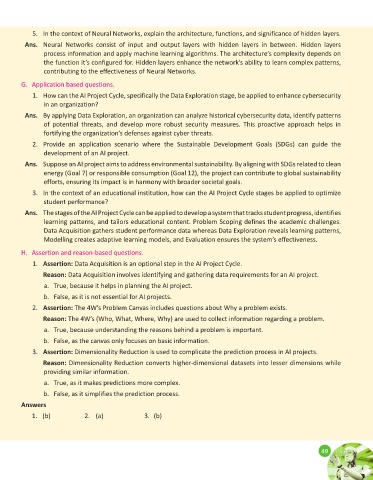Page 175 - Ai Book - 10
P. 175
5. In the context of Neural Networks, explain the architecture, functions, and significance of hidden layers.
Ans. Neural Networks consist of input and output layers with hidden layers in between. Hidden layers
process information and apply machine learning algorithms. The architecture’s complexity depends on
the function it’s configured for. Hidden layers enhance the network’s ability to learn complex patterns,
contributing to the effectiveness of Neural Networks.
G. Application based questions.
1. How can the AI Project Cycle, specifically the Data Exploration stage, be applied to enhance cybersecurity
in an organization?
Ans. By applying Data Exploration, an organization can analyze historical cybersecurity data, identify patterns
of potential threats, and develop more robust security measures. This proactive approach helps in
fortifying the organization’s defenses against cyber threats.
2. Provide an application scenario where the Sustainable Development Goals (SDGs) can guide the
development of an AI project.
Ans. Suppose an AI project aims to address environmental sustainability. By aligning with SDGs related to clean
energy (Goal 7) or responsible consumption (Goal 12), the project can contribute to global sustainability
efforts, ensuring its impact is in harmony with broader societal goals.
3. In the context of an educational institution, how can the AI Project Cycle stages be applied to optimize
student performance?
Ans. The stages of the AI Project Cycle can be applied to develop a system that tracks student progress, identifies
learning patterns, and tailors educational content. Problem Scoping defines the academic challenges.
Data Acquisition gathers student performance data whereas Data Exploration reveals learning patterns,
Modelling creates adaptive learning models, and Evaluation ensures the system’s effectiveness.
H. Assertion and reason-based questions.
1. Assertion: Data Acquisition is an optional step in the AI Project Cycle.
Reason: Data Acquisition involves identifying and gathering data requirements for an AI project.
a. True, because it helps in planning the AI project.
b. False, as it is not essential for AI projects.
2. Assertion: The 4W’s Problem Canvas includes questions about Why a problem exists.
Reason: The 4W’s (Who, What, Where, Why) are used to collect information regarding a problem.
a. True, because understanding the reasons behind a problem is important.
b. False, as the canvas only focuses on basic information.
3. Assertion: Dimensionality Reduction is used to complicate the prediction process in AI projects.
Reason: Dimensionality Reduction converts higher-dimensional datasets into lesser dimensions while
providing similar information.
a. True, as it makes predictions more complex.
b. False, as it simplifies the prediction process.
Answers
1. (b) 2. (a) 3. (b)
49
49

